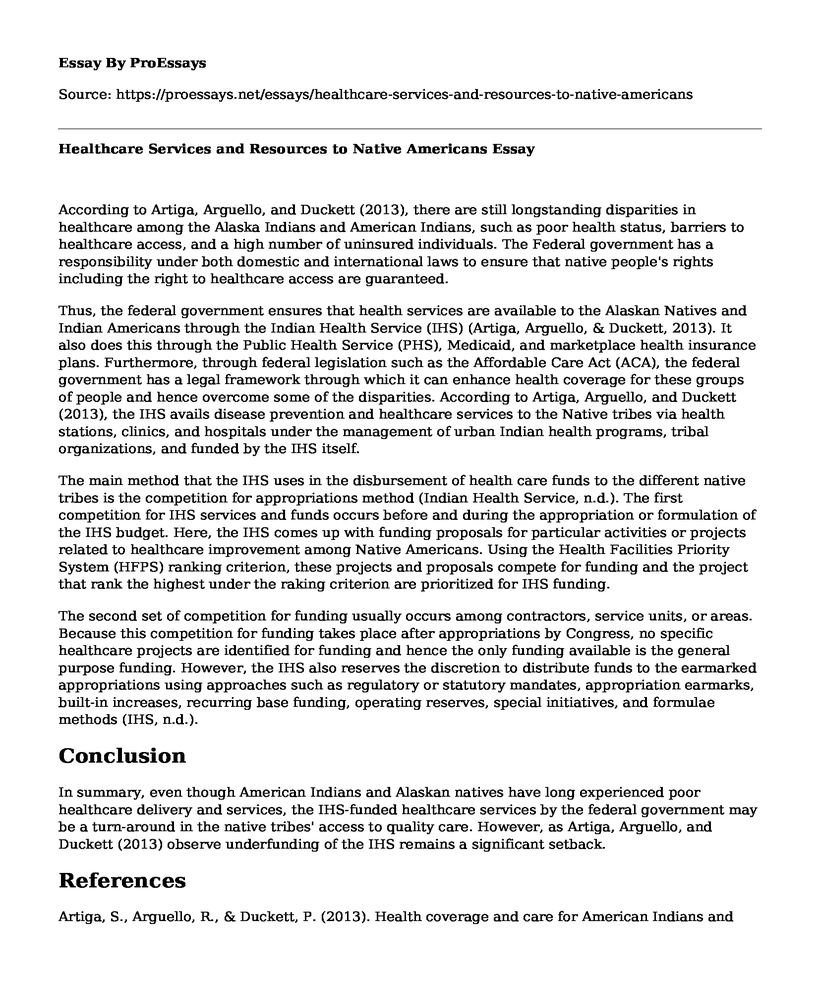According to Artiga, Arguello, and Duckett (2013), there are still longstanding disparities in healthcare among the Alaska Indians and American Indians, such as poor health status, barriers to healthcare access, and a high number of uninsured individuals. The Federal government has a responsibility under both domestic and international laws to ensure that native people's rights including the right to healthcare access are guaranteed.
Thus, the federal government ensures that health services are available to the Alaskan Natives and Indian Americans through the Indian Health Service (IHS) (Artiga, Arguello, & Duckett, 2013). It also does this through the Public Health Service (PHS), Medicaid, and marketplace health insurance plans. Furthermore, through federal legislation such as the Affordable Care Act (ACA), the federal government has a legal framework through which it can enhance health coverage for these groups of people and hence overcome some of the disparities. According to Artiga, Arguello, and Duckett (2013), the IHS avails disease prevention and healthcare services to the Native tribes via health stations, clinics, and hospitals under the management of urban Indian health programs, tribal organizations, and funded by the IHS itself.
The main method that the IHS uses in the disbursement of health care funds to the different native tribes is the competition for appropriations method (Indian Health Service, n.d.). The first competition for IHS services and funds occurs before and during the appropriation or formulation of the IHS budget. Here, the IHS comes up with funding proposals for particular activities or projects related to healthcare improvement among Native Americans. Using the Health Facilities Priority System (HFPS) ranking criterion, these projects and proposals compete for funding and the project that rank the highest under the raking criterion are prioritized for IHS funding.
The second set of competition for funding usually occurs among contractors, service units, or areas. Because this competition for funding takes place after appropriations by Congress, no specific healthcare projects are identified for funding and hence the only funding available is the general purpose funding. However, the IHS also reserves the discretion to distribute funds to the earmarked appropriations using approaches such as regulatory or statutory mandates, appropriation earmarks, built-in increases, recurring base funding, operating reserves, special initiatives, and formulae methods (IHS, n.d.).
Conclusion
In summary, even though American Indians and Alaskan natives have long experienced poor healthcare delivery and services, the IHS-funded healthcare services by the federal government may be a turn-around in the native tribes' access to quality care. However, as Artiga, Arguello, and Duckett (2013) observe underfunding of the IHS remains a significant setback.
References
Artiga, S., Arguello, R., & Duckett, P. (2013). Health coverage and care for American Indians and Alaskan Natives. The Henry J Kaiser Family Foundation Disparities Policy. Retrieved March 26, 2018, from https://www.kff.org/disparities-policy/issue-brief/health-coverage-and-care-for-American-Indians-and-Alaska-natives/
Indian Health Service. (n.d.). Indian health manual. Retrieved March 26, 2018, from https://www.ihs.gov/ihm/index.cfm?module=dsp_ihm_circ_main&circ=ihm_circ_9205
Cite this page
Healthcare Services and Resources to Native Americans. (2022, Apr 14). Retrieved from https://proessays.net/essays/healthcare-services-and-resources-to-native-americans
If you are the original author of this essay and no longer wish to have it published on the ProEssays website, please click below to request its removal:
- Critikal Thinking on Bananas Injected with HIV-Infected Blood
- African American Perceptions on the Use of Condoms Essay
- Essay Example on Social Activism: Taking Action for Essential Causes in Society
- Quality Indicators: Nursing & Patient Care Impact - Essay Sample
- Essay Example on Heart Failure: Causes, Risks & Treatments
- Essay Example on Caring for Traumatic Brain Injuries: Understanding Severity and Characteristics
- EPA Actions Against Ethylene Oxide Pollution - Free Paper Example







